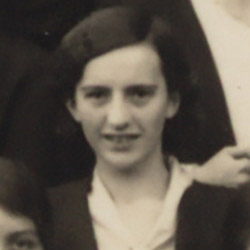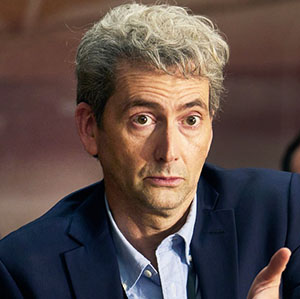“What is true on the scale of an inch is not necessarily true on the scale of hundreds of millions of light years,” J. Robert Oppenheimer told an audience at Colorado University in 1961. The Oppenheimer of these late lectures is a deep moral thinker who quotes the Gospels, the Bhagavad Gita, Sophocles and the French philosopher Simone Weil. A physicist’s view of the unimaginable scope of time and space is balanced by a very human immersion in cultural hindsight.
This Oppenheimer makes no appearance in Christopher Nolan’s Oppenheimer, which ends in the era of McCarthyism, when the national hero credited with bringing the war to an end was targeted in an ugly security hearing. Cillian Murphy’s portrayal gives us a different personality, with little of the physicist’s wry wit, and a more fragile sense of authority based on scientific brilliance rather than intellectual breadth.
Sam Shaw’s 2016 television series Manhattan gave an almost antithetical view to Nolan’s, with the great scientist, played by Daniel London, making only occasional appearances as a terse and inscrutable man who delivers peremptory rulings over the heads of those doing the hard grind of calculation and experiment at Los Alamos.
The story of Oppenheimer, like that of the Manhattan Project, can be told from different angles, but the angles don’t fit together. How did such breadth of hindsight fit with such constrained foresight? How did the party-going womaniser reconcile with the moral philosopher obsessed with questions of responsibility? How did the vocation of a gifted theoretical physicist map onto the overwhelmingly horrifying consequences of his work?
As with the inch and the light years, the cognitive dislocation has to do with matters of scale and distance. If the figure of Oppenheimer himself has all the cohesion of a Picasso portrait, this has surely to do with the fact that his mind was working in dimensions not accessible to most of us. “He’s complicated, capable of understanding and holding in his head contradictory ideas,” says Kai Bird, co-author of the biography on which the film is based.
Seen in hindsight and impersonated by a fine actor, as he is in the film, he may resolve himself into some kind of coherence, but hindsight is selective, easy to blend with invention and mould into narrative lines. Justifiably praised as it has been, Nolan’s Oppenheimer ultimately owes more to Hollywood than to history. The modern myth of the persecuted genius shows no signs of fading.
Shaw’s Manhattan skirts the heroic prototype altogether, and in many other respects forms a counterpart to the film. Shot on location in New Mexico, it recreates the township of Los Alamos with dedicated accuracy. For the cohort of scientists drafted in with their families, this “cross between a prison camp and a university campus” is not an easy place to live. In contrast to the string of dramatic moments Nolan creates across time and space, the episodic structure of a television series allows sustained attention as these people wander around the dusty, makeshift town in their city clothes.
The township is populated with invented characters: minor players in the project, their families and the workers brought in as servants from Mexican communities whose land is being occupied. While the men are at work the women make unsuccessful attempts to socialise in a setting where none of them are permitted to know anything about what is going on.
A divergence of views on the underlying physics of the bomb plays out in an alpha-male clash between two men: the hard-bitten Frank Winter (John Benjamin Hickey), leader of a dissenting team working on the implosion principle, and Charlie Isaacs (Ashley Zukerman), a prize-winning Harvard doctorate who arrived in July 1943, with load of tickets on himself, as part of the larger Oppenheimer-backed “Thin Man” cohort.
Manhattan’s script is designed to show how social and psychological factors are interwoven with theoretical convictions. You don’t have to follow the maths to pick up on the tensions generated by conflicting paradigms or the dual timelines measured on the ticking clock.
In a race to assemble the data before Oppenheimer leaves for the next briefing in Washington, Winter works through the night, interrupted by a giant scorpion marching across the wooden desktop as he scribbles equations; driving out into the desert to experiment with the accelerations of a golf ball under the car headlights. Meanwhile, the days crawl by for his wife Liza (Olivia Williams), a highly qualified botanist who has put her own career on hold, and their daughter Callie (Alexia Fast), desperate to escape to college in New York.
Stresses of another kind begin to escalate as bored military officers, on hand to enforce secrecy provisions, become overzealous, going through rubbish bins and opening personal correspondence. Things get ugly with the arrival of a plain clothes interrogator played by Richard Schiff (familiar to some viewers from The West Wing). With a relaxed manner and husky delivery, he assures his suspects: “Technically you’re nowhere, talking to no one.” Errors of judgement, betrayals and tragic consequences follow, and the town is subject to a regime of obsessive surveillance resembling conditions commonly associated with Stalinism.
All this is an important corrective to Nolan’s decision to depict the postwar witch-hunt against Oppenheimer without any attention to the precedents. Being accused of espionage was an occupational hazard for anyone who worked at Los Alamos. “It seems half of America’s physicists just disappeared,” says Winter at one point. “Pouff. Like the Rapture.” Curiously, Nolan casts Christopher Denham, who plays a member of Winter’s research cohort in Manhattan, as the real-life spy Klaus Fuchs, seen on the fringes of scenes in Oppenheimer as if he’s having a pretty easy time passing as one of the team.
The security theme has both political and social complexities: how is it possible to conduct any high-profile covert operation without attracting espionage? The film shows Oppenheimer as too trusting, or simply oblivious, as he focuses on technical matters while Fuchs hovers behind him. In Manhattan, he comes across as too ruthless to care what happens to those working under his management.
With audience numbers declining, Shaw’s series was terminated after season two. Watching it again now, it’s easy to see why, despite a uniformly excellent cast and the authentically evoked milieu. The characters lack edge and wit, and their obsessive sexual liaisons become tedious. Frank Winter, always dour and frustrated, just doesn’t have sufficient range to sustain the amount of screen time devoted to him. The bomb itself is never effectively conjured into presence, something Nolan manages unforgettably with a display of IMAX wizardry.
Both dramatisations provoke ethical questions by divorcing the story of what went on in Los Alamos from its consequences in Hiroshima and Nagasaki. But how, even hypothetically, could those two pictures be brought into meaningful dramatic relationship?
Here the older Oppenheimer serves as a fiercely articulate commentator. Speaking at the Princeton Theological Seminary in 1958, he began with the admission that “we are in trouble,” and proceeded to dwell on the sense of disharmony and imbalance that characterised the postwar era.
“Everything has got enormously bigger,” he said. “There are more people. The units of human activity have gotten bigger.” The scale of our enterprise as a species had defied our comprehension; the joint between tradition and innovation was “inflamed and in bad shape” and an “almost total collapse of valid communication” was evident in the public domain.
The words still ring true. And no matter how big the screen, we biological humans are perhaps only capable of seeing part of the picture. •




